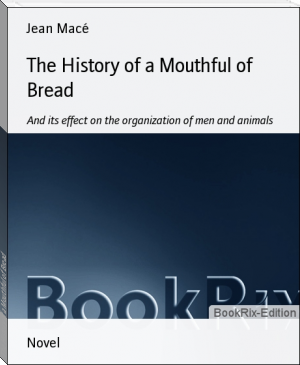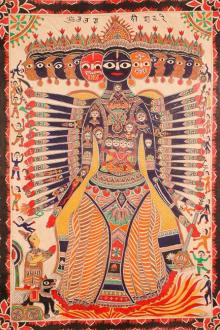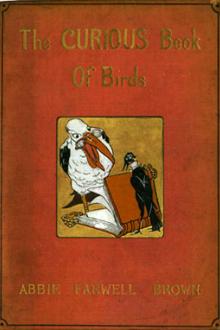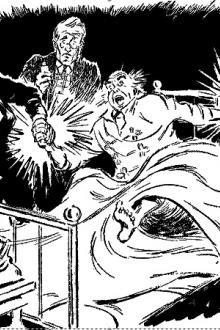The History of a Mouthful of Bread, Jean Macé [best autobiographies to read TXT] 📗

- Author: Jean Macé
Book online «The History of a Mouthful of Bread, Jean Macé [best autobiographies to read TXT] 📗». Author Jean Macé
together by a membrane springing from the body, with which they beat the air as with a wing, and which enables them to fly with such ease that theyare often taken for birds.
But, so far from really being a bird, this curious little creature has the same internal organization as ours, and indeed comes so near us, though without looking as if it did, that a scientific man, and a very distinguished one too, placed the bat in the first family of the animal kingdom, with the monkey, and, you will hardly believe it, with man. It is found that the bat, like man and the monkey, suckles its young at the breast; and it was this very character which Linnæus, the leader of artificial classification, thought of selecting as the distinguishing mark of his first family in the animal kingdom. It is true that in honor of the human race he had given that first family a much more sonorous name than our usual one of man -viz. primates , the first in rank-that is, the princes. But, alas! we were to be princes on an equality with bats; and, for my own part, I prefer being a bimane , and alone. I really believe that it was to put this saucy little creature back into its proper place that, at the time of the great revolution in favor of natural classification, the conclave of professors assembled at the Botanical Gardens in Paris inflicted this horrid name of Cheiroptera on the bat, ejecting it contemptuously from the overthrown dynasty of the primates .
I have not been sorry to make you acquainted as we went along, with this little trait in the history of classification; but beyond it there is really nothing particular to say about the apparatus for the nourishment of the deposed bat-princes, which is a plain proof how nearly it must be like our own. By-the-by, there is one trifling remark to be made with regard to her teeth. The bats we have in our country (France), for there are many varieties of species in the world, live on insects, which they catch in their flight by night. These insects are often enveloped in a very hard outer case, which molars like ours would have some difficulty in chewing properly; consequently the molars of our little friend are fringed with conical points, and with these she grinds down her prey without difficulty.
In America there is a large bat, the vampire, which lives on the blood of animals, and nature has armed it accordingly. It has at the extremityof its muzzle two sharp beak-like incisors, like the lancets of a surgeon. The vampire bat, which roams by night like other bats, goes straight at the large animals it sees asleep, delicately opens a vein in the throat without waking them, and sucks their blood in long draughts, taking care, by fanning them with its wings, to lull them into a cool and balmy slumber. It does not, as you see, make a savage attack on its victim: it merely inflicts a bite like that of the leech, but the result may be death. This is the best emblem I know of the sycophant, who undermines your soul while he fans your vanity; and observe, while we are on the subject, that this species has always had the art of insinuating itself among princes.
ORDER 4. Carnivora (flesh-eaters) .
When translated into English, this word needs no explanation. And here we have the tribe of bears, wolves, foxes, weasels, dogs, cats, tigers, lions, of all the fighting animals, i.e. , those which steep their muzzles in blood, and live by devouring others. These have a similar apparatus for nutrition to our own; especially the bear, who, with the monkey, is the animal most nearly resembling man, seeing that he has feet like ours, with scarcely any tail, while the monkey has our hands, without specifying any other points of resemblance. Like ourselves, too, the bear is omnivorous; that is to say, it eats everything, vegetables and fruit as well as meat; and nature, which has given it our diet, has furnished it with molars almost exactly like our own. Its canine teeth alone differ from ours: they are more prominent even than those of the quadrumana ; and this is the case with all the members of the order, in whom we find them sometimes developed into actual daggers. But those of them which are purely carnivorous have molars peculiar to themselves. The lion, for example, who does not share the bear's taste for carrots, and who would die of hunger surrounded by the honey and grapes of which the bear is so fond-the lion, who never takes anything but raw meat between his teeth, has molars furnished with sharp cutting edges, intended to slice the meat like the chopping knives used by cooks for making a hash.
The lion offers another peculiarity, which is common to him with all the Carnivora . Place your finger close to the lower end of your ear, and work your jaw; you will feel something hard moving backward and forward against your finger. This is where the lower jaw is set into a bone of the skull, called the temporal , if you care to know its name; in other words, the bone of the temple. The extremity of the jaw bends, and forms a kind of little knob, called condyle , which fits into a cavity of the temporal bone. With us the cavity is not very deep, nor the knob very large, so that it can play very freely; and it is this which allows us that second movement from side to side, of which I spoke to you formerly, and thanks to which, our little mills reduce a mouthful of bread into paste. But this freedom of action has also its inconveniences. You must never attempt to force too large an article into your mouth at once-an apple, for instance-the efforts you would then be obliged to make might easily cause the condyle to slip out of its little cavity, where its hold is but slight, and to get under the
temporal bone ; and there you would be with your mouth wide open until the doctor arrived. The lion, whose voracious jaw opens like the door of an oven, so that the tamers of wild beasts have no scruple in thrusting in their whole heads, a mouthful a good deal larger than an apple; the lion, who has no doctors, would often be liable to this accident-an irremediable one in his case-if nature had not made a special provision for him. In order to secure greater firmness and strength, the second movement is in his case sacrificed by embedding the condyles deeply in their cavities, where they are fastened in such a fashion that they can only move up and down, like the handles of a pair of pincers. This is a restraint which enables the jaw to be safely thrown open as wide as the fiery impulse of its terrible proprietor impels it. Less freedom, in exchange for more power, is a bargain which any one would gladly accept who plays the part of a lion!
I have here a remark to make. We have now passed in review three orders besides our own, and have only had to point out a change in the fastenings of the jaws and in the teeth; and you will find that the same sort of modifications take place in the whole class of mammals. This is in fact the essentially movable and variable point in their apparatus for nutrition. The jaw and its weapons vary their character from one species to another, according to the nature of their food; but the modifications generally terminate there, i.e. on the threshold, as it were. The interior arrangements of the house remain otherwise much the same in all.
Here, however, in the lion, there is an interior change to be described; but not in the arrangement of the parts, only in their size; the stomach in this species being even smaller and weaker in proportion than ours, and the digestive tube more than twice as short. The digestive tube of an ordinary sized man is about seven times the length of his body, whilst that of the lion only measures three times the length of the animal. This is a natural consequence of the kind of nourishment he takes. Flesh and blood, on which he lives entirely, is concentrated
albumen , prepared beforehand in the bodies of his victims; so that no great preparation is needed here to convert it into lion's blood. A professor of chemistry, who has a good assistant, does not need a very large laboratory. This is the case with the lion; and nature, which makes nothing in vain, has here economised space. Tame the monarch of the forest into a domestic animal, and change his food, and I will wager anything you please that, in the course of a few generations, his digestive tube will lengthen itself. Examine the inside of the cat, his little cousin, formed originally on the same pattern as himself, and, without having ascertained the fact myself, I am sure that, by dint of feeding it daily on sops and milk from generation to generation, its digestive tube has become more than three times the length of its body.
Here you ought to be told at once a very important fact relative to the organization of the lower animals, one which places them all very far below the order of Bimana , since there is such an order. In bestowing intelligence and freedom of action on man, the Almighty has given him the unspeakable privilege of working in His footsteps-if I may presume to use the expression-of following up His work of creation as it came from His hand. Now especially that man begins to see a little more clearly into the laws of life, he has entered more directly into the possession of this almost divine privilege, which the Almighty has graciously vouchsafed him. You can even now have an ox or a sheep made to order in England, giving your dimensions, as if you were ordering a cabinet; and in a few years, if you have not asked actual impossibilities, your commission will be executed to within an inch. This is not said in reference to the Carnivora . But in bidding you good-bye, my dear little mammal, I could not bear to leave you under the weight of that debasing title: I wanted also to show you your greatness.
LETTER XXXI.
MAMMALIA. (Mammals)-continued .
Let us continue to pass in review the different orders of the class Mammalia. We may meet elsewhere with facts more important to science, but nowhere with any so personally interesting to ourselves.
ORDER 5. Insectivora (insect-eaters) .
This order devours insects, as their name tells you plainly enough. They feed in the same manner as the bats; consequently they have molars like theirs, as was necessary. It is an unimportant little family, and we will not waste much time upon it. The chief of the order is the hedgehog, a native of our country-not very large, about nine inches long-which lives in the woods, and which when rolled up into a ball, with all its quills standing out, looks very much like an enormous horse-chestnut in its shell. Its canines have not much work to do, consequently they are very small; but, on the other hand, its two front incisors are prolonged beyond the others, the better to seize its prey, which creeps upon the ground. Internally there is nothing to remark upon.
Next to the
But, so far from really being a bird, this curious little creature has the same internal organization as ours, and indeed comes so near us, though without looking as if it did, that a scientific man, and a very distinguished one too, placed the bat in the first family of the animal kingdom, with the monkey, and, you will hardly believe it, with man. It is found that the bat, like man and the monkey, suckles its young at the breast; and it was this very character which Linnæus, the leader of artificial classification, thought of selecting as the distinguishing mark of his first family in the animal kingdom. It is true that in honor of the human race he had given that first family a much more sonorous name than our usual one of man -viz. primates , the first in rank-that is, the princes. But, alas! we were to be princes on an equality with bats; and, for my own part, I prefer being a bimane , and alone. I really believe that it was to put this saucy little creature back into its proper place that, at the time of the great revolution in favor of natural classification, the conclave of professors assembled at the Botanical Gardens in Paris inflicted this horrid name of Cheiroptera on the bat, ejecting it contemptuously from the overthrown dynasty of the primates .
I have not been sorry to make you acquainted as we went along, with this little trait in the history of classification; but beyond it there is really nothing particular to say about the apparatus for the nourishment of the deposed bat-princes, which is a plain proof how nearly it must be like our own. By-the-by, there is one trifling remark to be made with regard to her teeth. The bats we have in our country (France), for there are many varieties of species in the world, live on insects, which they catch in their flight by night. These insects are often enveloped in a very hard outer case, which molars like ours would have some difficulty in chewing properly; consequently the molars of our little friend are fringed with conical points, and with these she grinds down her prey without difficulty.
In America there is a large bat, the vampire, which lives on the blood of animals, and nature has armed it accordingly. It has at the extremityof its muzzle two sharp beak-like incisors, like the lancets of a surgeon. The vampire bat, which roams by night like other bats, goes straight at the large animals it sees asleep, delicately opens a vein in the throat without waking them, and sucks their blood in long draughts, taking care, by fanning them with its wings, to lull them into a cool and balmy slumber. It does not, as you see, make a savage attack on its victim: it merely inflicts a bite like that of the leech, but the result may be death. This is the best emblem I know of the sycophant, who undermines your soul while he fans your vanity; and observe, while we are on the subject, that this species has always had the art of insinuating itself among princes.
ORDER 4. Carnivora (flesh-eaters) .
When translated into English, this word needs no explanation. And here we have the tribe of bears, wolves, foxes, weasels, dogs, cats, tigers, lions, of all the fighting animals, i.e. , those which steep their muzzles in blood, and live by devouring others. These have a similar apparatus for nutrition to our own; especially the bear, who, with the monkey, is the animal most nearly resembling man, seeing that he has feet like ours, with scarcely any tail, while the monkey has our hands, without specifying any other points of resemblance. Like ourselves, too, the bear is omnivorous; that is to say, it eats everything, vegetables and fruit as well as meat; and nature, which has given it our diet, has furnished it with molars almost exactly like our own. Its canine teeth alone differ from ours: they are more prominent even than those of the quadrumana ; and this is the case with all the members of the order, in whom we find them sometimes developed into actual daggers. But those of them which are purely carnivorous have molars peculiar to themselves. The lion, for example, who does not share the bear's taste for carrots, and who would die of hunger surrounded by the honey and grapes of which the bear is so fond-the lion, who never takes anything but raw meat between his teeth, has molars furnished with sharp cutting edges, intended to slice the meat like the chopping knives used by cooks for making a hash.
The lion offers another peculiarity, which is common to him with all the Carnivora . Place your finger close to the lower end of your ear, and work your jaw; you will feel something hard moving backward and forward against your finger. This is where the lower jaw is set into a bone of the skull, called the temporal , if you care to know its name; in other words, the bone of the temple. The extremity of the jaw bends, and forms a kind of little knob, called condyle , which fits into a cavity of the temporal bone. With us the cavity is not very deep, nor the knob very large, so that it can play very freely; and it is this which allows us that second movement from side to side, of which I spoke to you formerly, and thanks to which, our little mills reduce a mouthful of bread into paste. But this freedom of action has also its inconveniences. You must never attempt to force too large an article into your mouth at once-an apple, for instance-the efforts you would then be obliged to make might easily cause the condyle to slip out of its little cavity, where its hold is but slight, and to get under the
temporal bone ; and there you would be with your mouth wide open until the doctor arrived. The lion, whose voracious jaw opens like the door of an oven, so that the tamers of wild beasts have no scruple in thrusting in their whole heads, a mouthful a good deal larger than an apple; the lion, who has no doctors, would often be liable to this accident-an irremediable one in his case-if nature had not made a special provision for him. In order to secure greater firmness and strength, the second movement is in his case sacrificed by embedding the condyles deeply in their cavities, where they are fastened in such a fashion that they can only move up and down, like the handles of a pair of pincers. This is a restraint which enables the jaw to be safely thrown open as wide as the fiery impulse of its terrible proprietor impels it. Less freedom, in exchange for more power, is a bargain which any one would gladly accept who plays the part of a lion!
I have here a remark to make. We have now passed in review three orders besides our own, and have only had to point out a change in the fastenings of the jaws and in the teeth; and you will find that the same sort of modifications take place in the whole class of mammals. This is in fact the essentially movable and variable point in their apparatus for nutrition. The jaw and its weapons vary their character from one species to another, according to the nature of their food; but the modifications generally terminate there, i.e. on the threshold, as it were. The interior arrangements of the house remain otherwise much the same in all.
Here, however, in the lion, there is an interior change to be described; but not in the arrangement of the parts, only in their size; the stomach in this species being even smaller and weaker in proportion than ours, and the digestive tube more than twice as short. The digestive tube of an ordinary sized man is about seven times the length of his body, whilst that of the lion only measures three times the length of the animal. This is a natural consequence of the kind of nourishment he takes. Flesh and blood, on which he lives entirely, is concentrated
albumen , prepared beforehand in the bodies of his victims; so that no great preparation is needed here to convert it into lion's blood. A professor of chemistry, who has a good assistant, does not need a very large laboratory. This is the case with the lion; and nature, which makes nothing in vain, has here economised space. Tame the monarch of the forest into a domestic animal, and change his food, and I will wager anything you please that, in the course of a few generations, his digestive tube will lengthen itself. Examine the inside of the cat, his little cousin, formed originally on the same pattern as himself, and, without having ascertained the fact myself, I am sure that, by dint of feeding it daily on sops and milk from generation to generation, its digestive tube has become more than three times the length of its body.
Here you ought to be told at once a very important fact relative to the organization of the lower animals, one which places them all very far below the order of Bimana , since there is such an order. In bestowing intelligence and freedom of action on man, the Almighty has given him the unspeakable privilege of working in His footsteps-if I may presume to use the expression-of following up His work of creation as it came from His hand. Now especially that man begins to see a little more clearly into the laws of life, he has entered more directly into the possession of this almost divine privilege, which the Almighty has graciously vouchsafed him. You can even now have an ox or a sheep made to order in England, giving your dimensions, as if you were ordering a cabinet; and in a few years, if you have not asked actual impossibilities, your commission will be executed to within an inch. This is not said in reference to the Carnivora . But in bidding you good-bye, my dear little mammal, I could not bear to leave you under the weight of that debasing title: I wanted also to show you your greatness.
LETTER XXXI.
MAMMALIA. (Mammals)-continued .
Let us continue to pass in review the different orders of the class Mammalia. We may meet elsewhere with facts more important to science, but nowhere with any so personally interesting to ourselves.
ORDER 5. Insectivora (insect-eaters) .
This order devours insects, as their name tells you plainly enough. They feed in the same manner as the bats; consequently they have molars like theirs, as was necessary. It is an unimportant little family, and we will not waste much time upon it. The chief of the order is the hedgehog, a native of our country-not very large, about nine inches long-which lives in the woods, and which when rolled up into a ball, with all its quills standing out, looks very much like an enormous horse-chestnut in its shell. Its canines have not much work to do, consequently they are very small; but, on the other hand, its two front incisors are prolonged beyond the others, the better to seize its prey, which creeps upon the ground. Internally there is nothing to remark upon.
Next to the
Free e-book «The History of a Mouthful of Bread, Jean Macé [best autobiographies to read TXT] 📗» - read online now
Similar e-books:





Comments (0)